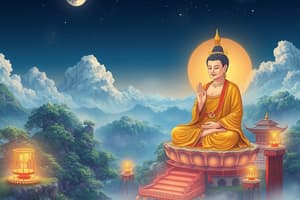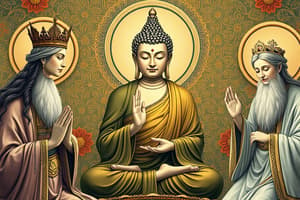Podcast
Questions and Answers
What role did silk play in the trade networks associated with Buddhism?
What role did silk play in the trade networks associated with Buddhism?
- It spurred demand and bolstered trade networks. (correct)
- It was mainly traded for agricultural goods.
- It was used primarily for clothing materials.
- It facilitated naval expeditions across the Mediterranean.
Which of the following consequences resulted from the economic impact of Buddhism in Kashmir?
Which of the following consequences resulted from the economic impact of Buddhism in Kashmir?
- Kashmir became entirely isolated from other regions.
- Agricultural practices declined due to overpopulation.
- Trade routes for Buddhist relics were established. (correct)
- Kashmiri peasants led a revolt against foreign traders.
What was a reaction of European peasants joining Buddhist activities?
What was a reaction of European peasants joining Buddhist activities?
- To expand their agricultural production.
- To establish trade with the Levantine territories.
- To seek economic relief or redemption. (correct)
- To participate in political movements.
What did Arab Nationalists label the Crusades as?
What did Arab Nationalists label the Crusades as?
In Juergensmeyer’s Stages of Religious Resurgence, what does Stage 4 represent?
In Juergensmeyer’s Stages of Religious Resurgence, what does Stage 4 represent?
What was a defining characteristic of the attacks linked to Christian militias in the USA?
What was a defining characteristic of the attacks linked to Christian militias in the USA?
What was the primary goal of coordinated attacks under Osama bin Laden?
What was the primary goal of coordinated attacks under Osama bin Laden?
Which of the following movements protested against secular governance in France?
Which of the following movements protested against secular governance in France?
What artistic style resulted from the fusion of Greco-Roman and Indian elements?
What artistic style resulted from the fusion of Greco-Roman and Indian elements?
Which regions benefited from the spread of Buddhism along the Silk Road?
Which regions benefited from the spread of Buddhism along the Silk Road?
What significant event did Pope Urban II initiate in 1095?
What significant event did Pope Urban II initiate in 1095?
Which of the following illustrates how religion and state have historically interacted?
Which of the following illustrates how religion and state have historically interacted?
What type of iconography did the Gandhara art style influence?
What type of iconography did the Gandhara art style influence?
Which of the following regions was NOT directly influenced by the spread of Buddhism?
Which of the following regions was NOT directly influenced by the spread of Buddhism?
What was a major feature of the First Crusade initiated by Pope Urban II?
What was a major feature of the First Crusade initiated by Pope Urban II?
Which of the following describes the impact of Buddhism's return to Tibet?
Which of the following describes the impact of Buddhism's return to Tibet?
What role does religion play during times of global uncertainty?
What role does religion play during times of global uncertainty?
Which symbol is mentioned as empowering religious movements related to violence?
Which symbol is mentioned as empowering religious movements related to violence?
What was a significant cause of international migration due to environmental reasons?
What was a significant cause of international migration due to environmental reasons?
Which of the following describes a type of migration that occurs within a country?
Which of the following describes a type of migration that occurs within a country?
As of 2019, what percentage of the world's population were migrants?
As of 2019, what percentage of the world's population were migrants?
What is one economic impact of migration on sending countries?
What is one economic impact of migration on sending countries?
What challenge associated with migration is noted regarding urban centers?
What challenge associated with migration is noted regarding urban centers?
What factor is demanding significant agricultural growth to sustain population increases by 2050?
What factor is demanding significant agricultural growth to sustain population increases by 2050?
What was a key outcome of the Iranian Revolution in 1979?
What was a key outcome of the Iranian Revolution in 1979?
What characterized the protests during the Arab Spring, especially in Tahrir Square in 2011?
What characterized the protests during the Arab Spring, especially in Tahrir Square in 2011?
What was a significant feature of Sikh Separatism in Punjab during the 1980s?
What was a significant feature of Sikh Separatism in Punjab during the 1980s?
How did the Afghan Jihad in the 1980s influence later groups like al Qaeda?
How did the Afghan Jihad in the 1980s influence later groups like al Qaeda?
Which key theme of religious conflicts is highlighted as acting as a cultural anchor?
Which key theme of religious conflicts is highlighted as acting as a cultural anchor?
What does the Push-Pull Model primarily focus on in terms of migration?
What does the Push-Pull Model primarily focus on in terms of migration?
What sentiment shifted in the 1990s, particularly towards global powers?
What sentiment shifted in the 1990s, particularly towards global powers?
What are common Push Factors in migration according to the content?
What are common Push Factors in migration according to the content?
Flashcards
Buddhism's Spread
Buddhism's Spread
Buddhism originated in Northern India and spread across regions like Central Asia, China, Korea, and Japan, primarily via the Silk Road.
Gandhara Art Style
Gandhara Art Style
A style of art that fused Greco-Roman and Indian elements, particularly in the depiction of the Buddha.
Silk Road
Silk Road
Historically important trade route that facilitated the spread of Buddhism and other ideas and goods; played a crucial role in connecting the East and West.
Buddhist Iconography Fusion
Buddhist Iconography Fusion
Signup and view all the flashcards
First Crusade
First Crusade
Signup and view all the flashcards
Religion and State Intertwined
Religion and State Intertwined
Signup and view all the flashcards
Early European Colonialism
Early European Colonialism
Signup and view all the flashcards
Buddhism's Influence in Central Asia
Buddhism's Influence in Central Asia
Signup and view all the flashcards
Economic Incentives in Missionary Activities
Economic Incentives in Missionary Activities
Signup and view all the flashcards
Silk's Role in Buddhism
Silk's Role in Buddhism
Signup and view all the flashcards
Buddhist Relic Trade
Buddhist Relic Trade
Signup and view all the flashcards
Juergensmeyer's Stage 1 of Religious Resurgence
Juergensmeyer's Stage 1 of Religious Resurgence
Signup and view all the flashcards
Juergensmeyer's Stage 4 of Religious Resurgence
Juergensmeyer's Stage 4 of Religious Resurgence
Signup and view all the flashcards
9/11 Attacks
9/11 Attacks
Signup and view all the flashcards
Economic Impact of Crusades
Economic Impact of Crusades
Signup and view all the flashcards
Religious Responses to Crises
Religious Responses to Crises
Signup and view all the flashcards
Iranian Revolution (1979)
Iranian Revolution (1979)
Signup and view all the flashcards
Sikh Separatism in Punjab (1980s)
Sikh Separatism in Punjab (1980s)
Signup and view all the flashcards
Buddhist Activism in Sri Lanka
Buddhist Activism in Sri Lanka
Signup and view all the flashcards
Stage 2: Internationalization of Religious Rebellion
Stage 2: Internationalization of Religious Rebellion
Signup and view all the flashcards
Afghan Jihad (1980s)
Afghan Jihad (1980s)
Signup and view all the flashcards
Anti-Western Sentiment (1990s)
Anti-Western Sentiment (1990s)
Signup and view all the flashcards
Role of Religion in Identity
Role of Religion in Identity
Signup and view all the flashcards
Push-Pull Model of Migration
Push-Pull Model of Migration
Signup and view all the flashcards
Role of Religion in Migration
Role of Religion in Migration
Signup and view all the flashcards
Religious Symbolism and Violence
Religious Symbolism and Violence
Signup and view all the flashcards
Global Migration: Internal vs. International
Global Migration: Internal vs. International
Signup and view all the flashcards
Pull Factors of Migration
Pull Factors of Migration
Signup and view all the flashcards
Economic Impact of Migration
Economic Impact of Migration
Signup and view all the flashcards
Cultural Impact of Migration
Cultural Impact of Migration
Signup and view all the flashcards
Challenges of Global Migration
Challenges of Global Migration
Signup and view all the flashcards
The Syrian Refugee Crisis
The Syrian Refugee Crisis
Signup and view all the flashcards
Study Notes
Section 1: Religion as a Globalizing Force
- Religion and state have historically worked together for spiritual and secular goals
- Ancient and medieval times show a fusion of religious and state interests
- This synergy is still seen in some states today
1. Buddhism as a Globalizing Agent
- Spread of Buddhism:
- Originated in Northern India and spread via the Silk Road
- Westward: Spread to Afghanistan, Bengal, and Central Asia
- Eastward: Spread to China, Korea, and Japan
- Returned to Tibet and influenced regions like Kyrgyzstan and Tajikistan
- Missionary activities helped establish Buddhism in remote areas
- Economic Impact:
- Silk's role in Buddhist rituals stimulated demand and trade networks
- Demand for Buddhist relics created a trade route for artifacts, encouraging cultural exchange
- Cultural Contributions:
- Gandhara art style blended Greco-Roman and Indian elements
- Depictions of Buddha revolutionized Buddhist iconography
- Spread to Central Asia and China, influencing monastic and architectural styles
Section 2: Christianity and the Crusades
- The First Crusade (1095):
- Initiated by Pope Urban II to reclaim the Holy Land
- Scholars see it as an early form of European colonialism with territorial ambitions
- Economic incentives, like trade routes in conquered areas, benefitted Italian city-states
- Social shifts occurred as European peasants sought economic relief or redemption
- Cultural and Political Impact:
- Arab nationalists labeled the Crusades as imperialist invasions
Section 3: Juergensmeyer's Stages of Religious Resurgence
- Religion responds to crises in globalization and secularism, evolving through stages.
- Stage 1: Isolated Outbursts (1970s-1980s): Events like the Iranian Revolution, Sikh separatism, and Buddhist activism in Sri Lanka highlight this stage.
- Stage 2: Internationalization of Religious Rebellion: Events like the Afghan Jihad illustrate this stage.
- Stage 3: Anti-Western Sentiment (1990s): This stage focuses on global centers of power, including the USA and Europe.
- Stage 4: Global War (Post-9/11): Examples include the coordinated attacks by global jihadist networks, and the rise of the "War on Terror"
Section 4: Religion in Modern Global Conflicts
- Key Themes in Religious Conflicts:
- Identity: Religion acts as a cultural anchor amidst globalization.
Section 5: Global Migration
- Types of Migration:
- Internal: Migration within a country, like rural-to-urban migration
- International: Migration across borders for work, safety, or permanent residence.
- Global Figures:
- 272 million migrants in 2019, representing 3.5% of the global population.
- Top Origin Countries: India, Mexico, and China were top origin countries in 2019.
- Migration's Impact:
- Economic: Remittances bolster sending countries' economies.
- Push Factors:
- Economic (unemployment, poverty), political/religious(persecution, war), and environmental(rising sea levels)
- Pull Factors:
- Economic (higher wages), social(religious freedom), and political
- Challenges:
- Overcrowded urban centers and food security concerns
Studying That Suits You
Use AI to generate personalized quizzes and flashcards to suit your learning preferences.




